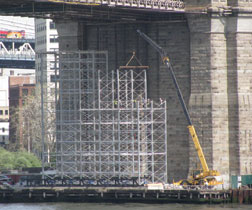New York City’s $15.5-million Waterfalls Project may be a work of art that has perked up the aging East River waterfront, at least temporarily this summer, but for its engineer and contractor, it was like any other tough job in the Big Apple.
 STV Engineers
|
It was no simple feat turning artist Olafur Eliasson’s concept into the four 120-ft-tall freestanding structures that pour millions of gallons of water in tumbling cascades from four locations between Manhattan and Brooklyn. What has been hailed as brilliant art since its June debut required months of permitting and countless decisions on site selection, materials and subcontractors, all under the artist’s careful watch. “There is no manual for a project like this” says Tom Hoban, senior vice president at New York City-based Tishman Realty & Construction Co. Inc., the construction manager. “For the past two years, we met regularly with the artist to discuss design solutions to complete his vision.”
The firm was first contacted in mid-2006 to manage the job. “Given the unique nature of the project, the permitting process was particularly arduous,” says Tishman Vice President Pamela Friedlander. “In the end, we obtained 20 permits and met with over 30 agencies.”
Initially, neither the number of waterfalls envisioned nor their locations was specified. Site selection alone took six months, says Nick Altebrando, project manager for its engineer, STV, New York City. Four site finalists emerged: one underneath the Brooklyn Bridge, two at old piers on the Manhattan and Brooklyn sides of the river, and one on nearby Governor’s Island. Construction did not begin until last March, under much secrecy, to avoid spoiling the June debut.
 STV Engineers
Waterfalls Project at New York City sites, including the Brooklyn Bridge, was complicated.
|
Since the project is temporary, set to be dismantled in October, there was an effort to avoid disturbing the sites by drilling foundations. “The two old piers were built to take heavy loads, but the site under the bridge had to be prepared,” says Altebrando. “It was on fill that had collected over the years since the bridge was built in 1886, and the city had to do some repairs before we could work there.” He says the Governor’s Island site required many archeological surveys, out of which “they found all kinds of stuff.”
Erecting the waterfalls themselves required several construction methods. Heavy plastic sheeting was spread over the ground, over which concrete bases were poured. Scaffolding is extruded aluminum tubing used for especially large facades. The artist had wanted standard pipe scaffolding, but it was too small for the 100-ft water pipes required, says Altebrando. “A lot of time was spent trying to get everyone on the team to understand the physical magnitude of the components,” he adds.
Creation of the waterfall was an engineering challenge. “The dam weir slots give it a streaming effect, while a second weir’s texturing gives it the cascading effect,” says Hoban. An intake pond at the bottom, engineered to meet strict environmental rules, uses a below-tide intake with a fine micron mesh to keep out aquatic life.
The bridge falls created some concern last month when an under-span cafe complained that salt spray was harming nearby trees. “There is a anemometer, a wind meter, at each site that is programmed to shut off each waterfall when sustained winds occur,” says a Tishman spokesman. But Hoban says the project drew many willing participants, including some who donated services or performed work at cost.


Post a comment to this article
Report Abusive Comment